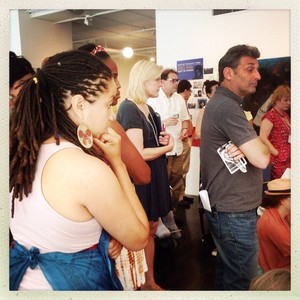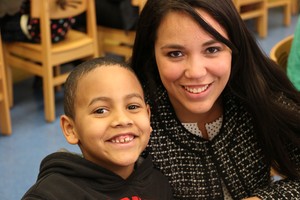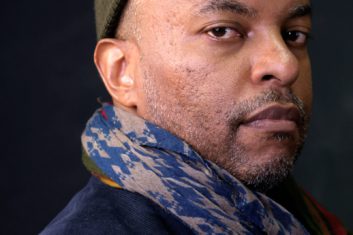Summer Institute 5.0: A guide for moving from question to response
I believe to truly ingest life lessons one must recognize the path that led to the circumstance.
As I thought about my story and how I came to be in The 8th Floor gallery in Manhattan surrounded by people equal parts teacher and artist, my memory took me back to reading stories with my mother about Oscar the Grouch giving a tour of his trashcan paradise. I remember asking those first questions: Why is Oscar grumpy and in a trashcan, and where are his parents, and if he’s so angry how does he still have friends? I turned these questions into daydreams.
Forward to my early teens, as I glided through downtown Detroit (holding a poem printed on a large board like a picket sign) on my pink and white rollerblades behind my poetry coach and team of spoken and written word artists in a poetic protest against poverty and exclusion.
Later, in my early twenties, I chatted with once-admired fathers and veterans now without home or family contact, making due with their few migrating belongings along the Pacific coast of San Diego. Years ahead, I wound up at a non-profit at an old fire station in Kalamazoo. There, I unloaded my students’ curiosity around poverty and exclusion into research projects. Last year, I found a new family as a volunteer at the Ruth Ellis Center (Detroit), learning to navigate my own identity and questions in raw conversations with the homeless (or nearing homelessness) LGBTQ youth of the city.
One moment leading to the next reality: Scaffolding.
The surest way to help students ask questions, search for answers, and create influential art for social justice is in creating a clear path for understanding and success.

Renee Watson and Patti Chilsen, the facilitators of the three-day Community-Word Project Summer Institute training, designed a program to aid artists in teaching social justice in the classroom.
I had attended such trainings before through other organizations. Most often, the trainings consisted of statistics about poverty, race, class, immigration, etc, lectures by celebrity activists; workshops that felt swift and incomplete, presentations of finished artistic projects, and (of course) panel discussions. These trainings, while somewhat helpful, often left me feeling like a server had rushed me away from a plate of half-eaten, beautifully arranged food to sit another salivating party.
Three days, when discussing social justice, is still quite short. However, Patti and Renee carefully scheduled the day in such a manner that I walked away not only further impassioned, but with practical and adaptable lesson plans, a handful of materials, experience in multiple artistic disciplines, and language fitting to the Common Core demands of most classrooms. Their key to preparing us: scaffolding. We became the students and we followed the path. I will walk through the most influential day for me, day 2, which modeled several classroom sessions within just a few hours.
When scaffolding, it is best to start with the space. The 8th Floor hosted a visual art exhibit evoking a variety of questions about identity, body, culture and performance. Paintings, photographs, drawings and installations against the white walls left with room for postings set the scene for training and creation. The facilitators made sure we moved around the space for variety in the movement and pace of activities. Patti led the attendees through a series of breathing, stretching, listening and vocalizing, as Renee worked on the other side of the gallery to prepare the next activity.


When scaffolding, it is best to have help building. Patti and Renee took turns leading us and preparing the next phase of the day so that activity had a seamless flow. We remained engaged as we shifted from body exercises with Patti to a window gallery of images of young black folks killed by authority over the decades set by Renee just minutes before we migrated to that area of the space. We were instructed to silently respond on sticky notes to the images as music reflective of the black experiences for justice played solemnly.




When scaffolding, it is best not to give answers. Instead, create a level playing field of information. We were divided into groups, given articles to read relaying the stories of the images we had just viewed, and given paper guides to chart our reactions. In large-group discussion we simply shared the facts and similarities of each article, shying away from drawing conclusions or sharing opinions. This changes the normal flow of artistic teaching, in which we ask students to decipher a poem or piece about subjects they may have no factual background from which to interpret the art.


Bring the voices of artists not already in the room. We read and listened to poems reacting to the facts of how the young black lives were taken, giving real or imagined human qualities to names that had become news stories. We talked about the poet being a poet and a reporter. The discussion was about interpretation as much as a lesson in craft. When scaffolding, show future artists how the artistry works. Reveal the technique.
The building of body and space consciousness, factual grounding, and examining artistic response led us to creating our own art. When scaffolding, make the expectations clear. We were given a rubric of how to craft our poetic response, and encouraged to use our chart of reactions to help us move through our poem. After a few people shared, we rejoined our groups to create a single poem. When scaffolding, be sure the community actually communes.




Finally, we were challenged to turn our poem into a performance that we would take to the streets of New York. We were given tools to be musical, to have movement, and to work cohesively. When scaffolding, do not be afraid to go outside of the structure. We left the building, performed our work in a non-traditional theatrical space (the street), and felt the pressure, energy and challenge of real social justice work.




Finally, Renee and Patti led a discussion back at The 8th Floor in how they designed the day and why. It is important to help the student understand the purpose of the blueprint. How did each moment lead to the next? Patti and Renee explained how this day could work as several sessions with our students, what worked and didn’t work, and adaptability.
In the Summer Institute, every voice in the space, every moment, every movement is a resource. The same is true in an open and effective classroom. By being the student, we experienced the lessons from critical viewpoints as both a participant and a facilitator. As a result, I left a better artist, teacher and curator for experiences for social change. And while I still had more questions and desire for even more intricate training, I left feeling prepared and full.


Four days later, I led my group of third graders through an exercise, scaffolding the lesson to end with them asking questions about body-type discrimination. And they did ask questions, one even quoting Mother Teresa about gender discrimination from a book he had found earlier in the summer. Third graders! One moment- leading to the next reality.
-Shawntai Brown, Writer, Summer Institute 5.0 Participant
Interested in Summer Institute? Find out more about it in our Summer Institute 5.0 Anthology.
Want to know more about Professional Developement opportunities with CWP? Check out our Teaching Artist Training & Internship Program (TATIP).



